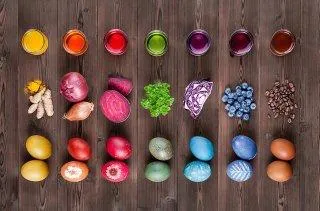
A little history: Why we colour eggs for Easter?
Colourful eggs and Easter have been closely intertwined for centuries. Since people in the Middle Ages did not only refrain from eating meat but also eggs during the fasting period, many eggs were collected until Easter. The eggs were preserved by cooking, often on Holy Saturday, the so-called "Saturday of dyeing". The colouring of the eggs also had a purpose. The colouring of the eggs made it possible to distinguish the boiled eggs from the raw eggs. The German physician and botanist Georg Franck von Franckenau reported as early as 1682, in his writing "Satyrae", that the coloured eggs were hidden in order to have children search for them.
In the Middle Ages, however, there were no synthetic colours to give eggs a colourful coating. The farmers used fruits, vegetables, root parts and onion shells to dye eggs. Even today, you can safely do it without chemistry, because nature provides us with enough dyes. Dying eggs naturally is a great experience for children. They are often amazed by the dyeing power of the plants.
You work best with white eggs. White eggs take on the colour far better than brown eggs, especially if you rub them briefly with damp kitchen paper and some vinegar before dyeing. The vinegar degreases the skin so that the pigments adhere better and more evenly. Regardless of whether you dye beetroot, spinach or onions - the colour results are not bright, but soft and pastel like.
To dye Easter eggs with the natural substances, boil the dyeing materials in a litre of water to a so-called broth and let them infuse for 15 minutes.
Now you put the eggs in the broth. How long is up to you. Observe how different brown and white eggs take on the colour. Eggs that have just been hard-boiled and are still warm usually take up the colours best.
If this is too hectic for you, you can also cool your eggs and broth and leave them in the brew all day or overnight.
If you're too bored with one color, nature has a great trick to conjure up patterns on the Easter eggs: With the acids that are in vinegar and lemon juice, you can etch away the top layer of color a little bit! Simply apply patterns with a cotton swab and the best patterns will appear!
The longer the acid acts on a spot, the brighter it becomes there. Sounds dangerous, but is completely harmless. And of course the eggs remain edible.
You can find even more inspiration for Easter on our Pinterest Board:
https://www.pinterest.ch/stadtlandkind/easter/


 Thank you! You have successfully entered the newsletter!
Thank you! You have successfully entered the newsletter! 

